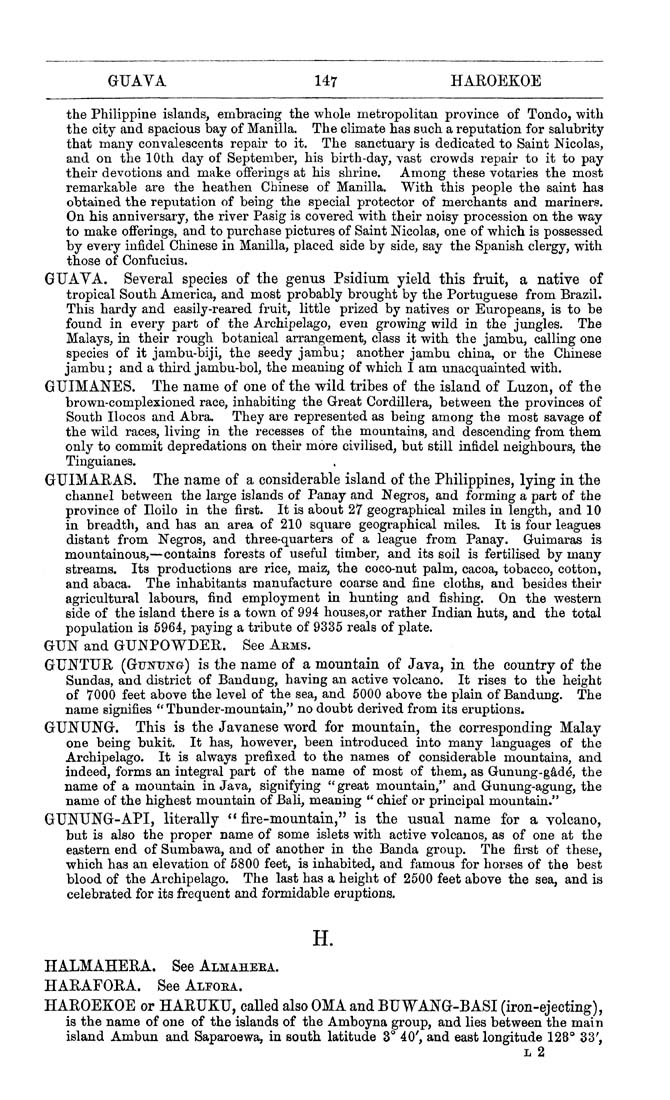GUAYA 147 HAROEKOE
the Philippine islands, embracing the whole metropolitan province of Tondo, with
the city and spacious bay of Manilla. The climate has such a reputation for salubrity
that many convalescents repair to it. The sanctuary is dedicated to Saint Nicolas,
and on the 10th day of September, his birth-day, vast crowds repair to it to pay
their devotions and make offerings at his shrine. Among these votaries the most
remarkable are the heathen Chinese of Manilla. With this people the saint has
obtained the reputation of being the special protector of merchants and mariners.
On his anniversary, the river Pasig is covered with their noisy procession on the way
to make offerings, and to purchase pictures of Saint Nicolas, one of which is possessed
by every infidel Chinese in Manilla, placed side by side, say the Spanish clergy, with
those of Confucius.
GUAYA. Several species of the genus Psidium yield this fruit, a native of
tropical South America, and most probably brought by the Portuguese from Brazil.
This hardy and easily-reared fruit, little prized by natives or Europeans, is to be
found in every part of the Archipelago, even growing wild in the jungles. The
Malays, in their rough botanical arrangement, class it with the jambu, calling one
species of it jambu-biji, the seedy jambu; another jambu china, or the Chinese
jambu; and a third jambu-bol, the meaning of which I am unacquainted with.
GUIMANES. The name of one of the wild tribes of the island of Luzon, of the
brown-complexioned race, inhabiting the Great Cordillera, between the provinces of
South Ilocos and Abra. They are represented as being among the most savage of
the wild races, living in the recesses of the mountains, and descending from them
only to commit depredations on their more civilised, but still infidel neighbours, the
Tinguianes.
GUIMARAS. The name of a considerable island of the Philippines, lying in the
channel between the large islands of Panay and Negros, and forming a part of the
province of Iloilo in the first. It is about 27 geographical miles in length, and 10
in breadth, and has an area of 210 square geographical miles. It is four leagues
distant from Negros, and three-quarters of a league from Panay. Guimaras is
mountainous,—contains forests of useful timber, and its soil is fertilised by many
streams. Its productions are rice, maiz, the coco-nut palm, cacoa, tobacco, cotton,
and abaca. The inhabitants manufacture coarse and fine cloths, and besides their
agricultural labours, find employment in hunting and fishing. On the western
side of the island there is a town of 994 houses,or rather Indian huts, and the total
population is 5964, paying a tribute of 9335 reals of plate.
GUN and GUNPOWDER. See Arms.
GUNTUR (GuifUNG) is the name of a mountain of Java, in the country of the
Sundas, and district of Bandung, having an active volcano. It rises to the height
of 7000 feet above the level of the sea, and 5000 above the plain of Bandung. The
name signifies " Thunder-mountain," no doubt derived from its eruptions.
GUNUNG. This is the Javanese word for mountain, the corresponding Malay
one being bukit. It has, however, been introduced into many languages of the
Archipelago. It is always prefixed to the names of considerable mountains, and
indeed, forms an integral part of the name of most of them, as Gunung-g^d^, the
name of a mountain in Java, signifying "great mountain," and Gunung-agung, the
name of the highest mountain of Bali, meaning " chief or principal mountain."
GUNUNG-API, literally ** fire-mountain," is the usual name for a volcano,
but is also the proper name of some islets with active volcanos, as of one at the
eastern end of Sumbawa, and of another in the Banda group. The first of these,
which has an elevation of 5800 feet, is inhabited, and famous for horses of the best
blood of the Archipelago. The last has a height of 2500 feet above the sea, and is
celebrated for its frequent and formidable eruptions.
H.
HALMAHERA. See Almaheea.
HARAFORA. See Alfoea.
HAROEKOE or HARUKU, called also OMA and BUWANG-BASI (iron-ejecting),
is the name of one of the islands of the Amboyna group, and lies between the main
island Ambun and Saparoewa, in south latitude 3° 40', and east longitude 128° 33',
L 2
|








